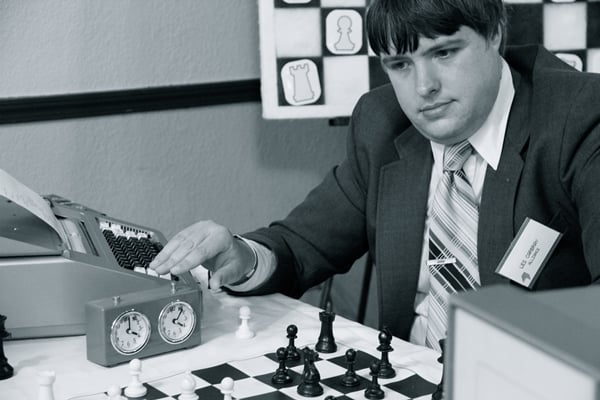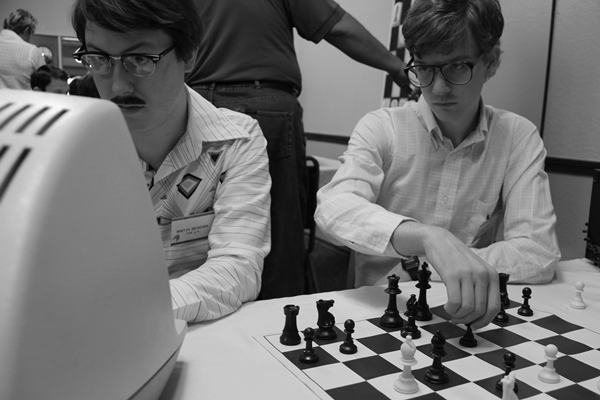Art & Exhibitions
Why Is Our Era’s Greatest Art Movement Missing from the Whitney Biennial?
Internet art makes a fleeting appearance this year and has consistently been ignored.

Internet art makes a fleeting appearance this year and has consistently been ignored.

Paddy Johnson


Andrew Bujalski, still from Computer Chess (2013).
Courtesy the artist .Copyright 2013 Computer Chess LLC. Photograph by Alex Lipschultz.
In this year’s Whitney Biennial, the only bit of Internet art on display could easily be missed. It’s a command line that looks like this:
|:
|:
|:The best of Artnet News in your inbox.
It appears in a scene near the end of Andrew Bujalski’s black-and-white feature film Computer Chess, screening in the Whitney’s second-floor film and video gallery. The repeated command streams down the left side of a computer’s screen, mimicking the scene’s rainstorm and echoing its grim mood. It’s a death scene, and that expressionless emoticon sums up the nuts of bolts of a movie about the differences between programmed behavior and human behavior.
That computer death scene comes a little late in the context of the Whitney Biennial, which seems to have pulled the plug on the Internet art medium long ago. Over the course of the last six biennials, the museum has shown a total of two artists who use computer hardware as a core part of their practice, and they had created a collaborative piece—by Cory Arcangel and Paul B. Davis, in 2004.
Artists whose practices exist almost exclusively on the Internet have been all but non-existent in every Biennial since 2002. That year’s show was an irregularity among biennials. It followed the 2001 exhibition “BitStreams,” the Whitney’s most significant foray into net art, and exploration of the dot com boom’s impact on art. The 2002 Biennial had a whole section devoted to net art and included works by several new media artists, including Mark Napier, Mary Flanagan, Yael Kanarek, Stephen Vitiello, and John Klima.

Andrew Bujalski, still from Computer Chess (2013).
Courtesy the artist. Copyright 2013 Computer Chess LLC. Photograph by Alex Lipschultz.
But one Biennial in 12 years with decent representation of what has become a major field of contemporary art isn’t a very good record. Other museums and galleries are recognizing the importance of new media and Internet art. Artist Lorna Mills recently curated an animated GIF show to compliment the David Bowie exhibition at the Art Gallery of Ontario. Steve Turner Contemporary now represents Petra Cortright, an artist who got her start online. And Zach Feuer represents Jon Rafman, best known for his Google Street View series, The Nine Eyes of Google Street View, and is showing Brad Troemel, co-founder of the popular blog The Jogging—whose exhibition I reviewed here.
The net art field is admittedly more international than the Biennial’s US focus typically allows, but that’s not to say there aren’t plenty of artists to chose from. And New York has no shortage of media-friendly galleries, non-profits, and curators. Transfer Gallery alone has shown enough new media art to fill the Biennial five times over, not to mention what gets shown by the non-profits 319 Scholes, Rhizome, and Eyebeam. Curators aren’t that hard to find either, as those working in the field of new media never stop organizing shows. Karen Archey, Christiane Paul, Kelani Nichole, and Lindsay Howard are just a few resources that could easily be tapped for the job.
And luckily the Whitney will have plenty of additional space and resources to make this happen in the 2016 Biennial, the first in its new Meatpacking District building. Two years from now, I’d like to see the museum focus on artists working with the Internet and engaged with digital art. The field is simply too large and networked to ignore.
The dark mood of Computer Chess’s death scene may reflect feelings many of us have about the current state of contemporary art as a whole, but it doesn’t tell the full story of artists working in the digital space. It’s a great time for online makers. What’s happening online is the closest thing we have to a major art movement today, and that’s something to celebrate and showcase.